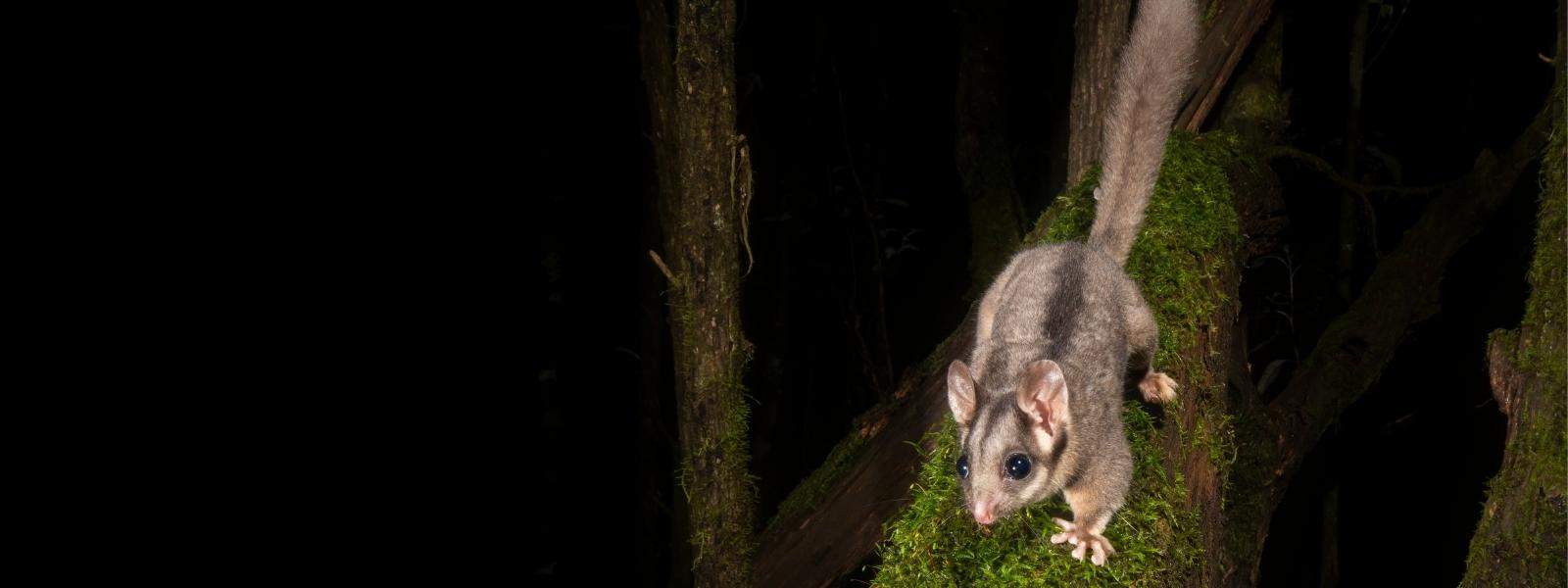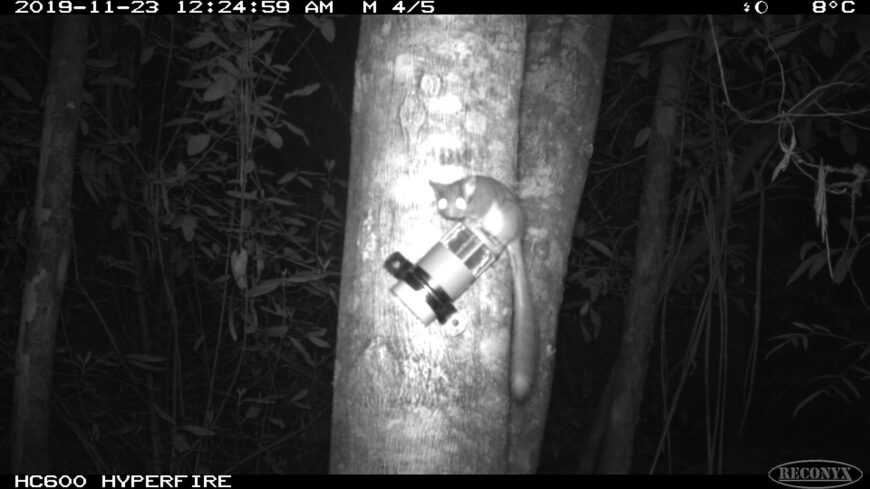NEWS UPDATE |
Draft plans gathered dust for nearly a decade while Leadbeater’s habitat was systematically destroyed by the fraught native forest logging industry. Federal Environment Minister acknowledged this at the plan’s release “historical timber harvesting in Victoria and bushfires have had a devastating impact on Leadbeater’s Possum habitat.”
New threats have emerged from the recent end of native forest logging on public land, such as broad acre habitat tree removal across the Yarra Ranges National Park.
We hope this evidence-based approach gives the Leadbeater’s Possum, also known as the fairy possum, a real chance to recover. With a clear emphasis on habitat protection and connectivity, the long overdue plan can bring this tiny marsupial back from the brink of extinction.
It takes a lot of waiting, a lot of knowledge, and a lot of luck to see a Leadbeater’s Possum in the wild. Once you do, it’s a mix of celebration, excitement, and deep sadness.
The reason they are so difficult to catch a glimpse of is not just because they are small, fast-moving, nocturnal and live in some of the tallest trees in the world – they are also Critically Endangered and found in only a few small patches of forest in Victoria.
I saw my first ‘Leadie’ many years ago on Taungurung Country in Nolan’s Gully in Toolangi State Forest. As the sun set and the birds went to sleep, we sat at the base of a large old tree and peered upwards. Known as ‘stag’ trees, large old or dead trees are a vital part of the Leadbeater’s Possums ecology as these little animals can push through vertical cracks in the trunk to access internal hollows to nest. After searching the darkness, to finally spot a fluffy tail and those big round eyes in among the branches was incredibly thrilling.
Not least because for 50 years, Leadbeater’s Possum was thought to be extinct. Gymnobelideus leadbeateri was first described scientifically from animals collected from the Bass River in West Gippsland on the edge of the once vast Koo-Wee-Rup swamp. But draining of the swamp and land clearance following European colonisation had a devastating impact on their habitat and populations.
Then in 1961, they were miraculously rediscovered in the forest of Cambarville and Tommy’s Bend near Marysville in the Central Highlands by naturalist Eric Wilkinson.

Ten years later, in 1971, Leadbeater’s Possum was proclaimed Victoria’s mammal emblem, or ‘state animal’, due to it being our only endemic (only found in a specific area or region) mammal species. Biologically this marsupial is an oddity, being the only species in its genus, and more closely related to the Striped Possum in Queensland than to the Brushtail and Ringtail possums that run across your roof at night.
Their average length is 33 centimetres, half of which is their long tail. They live in matriarchal family colonies of up to 12 individuals, with one monogamous breeding pair. They defend their roughly three-hectare territory and den together in nests they build in tree hollows six to 30 metres above the ground. Emerging at dusk, they forage for insects and nectar and jump through the understory with bundles of shredded bark held in their tails for nest building, like hikers with their swag on their back looking for a place to bunk down.
Despite the recognition of becoming a state emblem, Leadbeater’s Possum continues to be vulnerable due to its restricted distribution and the destruction of hollow-bearing trees, and is increasingly threatened by logging and fire.
The largest population is isolated in the ash forests of the Central Highlands, exposing it to direct conflict with the state government-run native forest logging industry destroying its remaining habitat. Combined with the increasing severity and size of wildfires due to our changing climate, the species is on the precipice of steep declines in its population.
A small subpopulation of the lowland Leadbeater’s Possum found in Yellingbo Nature Conservation Reserve in the Yarra Valley also faces great uncertainty. Legislation was passed by the Victorian Parliament in 2020 to create the Yellingbo Landscape Conservation Area, a new category under the National Parks Act 1975. This will help link reserves and remnant vegetation along the local rivers, including the Yarra River and Woori Yallock Creek. Although a lot of restoration work lies ahead, these corridors will help both Leadbeater’s Possums and their neighbours Helmeted Honeyeater move through the landscape while also helping improve the water quality in the region.
A monitoring program in the Central Highlands established by David Lindenmayer in 1983 is one of the world’s longest-running of its kind and covers different land tenures, including national park, state forest, reference areas and water catchments. This program has found the declines of the Leadbeater’s Possum and other species such as the Greater Glider are being caused by the loss of large old or dead hollow-bearing trees from widespread industrial logging.
As such, the campaign to protect the Leadbeater’s Possum and other forest-dependent wildlife in the Central Highlands has a significant focus on protecting stag trees. This involves allowing the oldest stands of trees, currently around 80 years old, to grow on and become our old growth forest of the future. And they aren’t very far off reaching this age. Hollows necessary for nesting can take 100-150 years to develop in living trees. But being large old or dead trees, they are very fragile and susceptible to destructive logging and fire. The 2009 Black Saturday bushfire burnt 43 per cent of Leadbeater’s Possum habitat in the Central Highlands, possibly halving the wild population.

The last state government led action for the Leadbeater’s Possum was in 2014 under the Baillieu/Napthine government, which established the Leadbeater’s Possum Advisory Group. This Advisory Group delivered recommendations to “support the recovery of Leadbeater’s Possum while maintaining a sustainable timber industry”. That led to small protections of 200-metre buffer zones for Leadbeater’s Possum detected in forests being logged. This was against the scientifically recommended 1000-metre buffers and, more likely than not, doesn’t protect the animals nesting place, as the protection is based on where an animal is recorded, which could be several hundred metres away from its denning tree. At the 2014 state election, Labor looked at creating a new national park in the Central Highlands to protect Leadbeater’s Possum and other species, but this was blocked after an intervention from the CFMEU and others. The campaign for a ‘Great Forest National Park’ is ongoing.
As part of the Andrews Government 2019 announcement of a transition out of native forest logging, with 90,000 hectares of what they deem “old growth forest” to be protected across the state and an additional 96,000 hectares to be Immediate Protection Areas (IPAs) to protect Greater Gliders. Unfortunately, very few of the yet-to-be-formalised IPAs are suitable as the Leadbeater’s Possum habitat. Until all their habitat is removed from logging plans, their fate is still on the chopping block. Meanwhile, in November this year the Andrews Government legislated variation to the Code of Practice for Timber Production, the rules governing logging, which weakens protection for wildlife and forest ecosystems.
Although the government has largely given up on directly protecting Leadbeater’s Possum, the community have stepped up. Groups like Friends of Leadbeater’s Possum and Wildlife of the Central Highlands have continued survey work in the forests, protecting hundreds of hectares of habitat from the bulldozers and have taken on and won a major court battle against the state government’s logging agency VicForests about the legality of logging in threatened species’ habitat (now under appeal to the High Court).
As President of the Friends of Leadbeater’s Possum, Steve Meacher says: “it’s the little possum that roared” – and those roars are not getting any quieter. Surely our state emblem, and the importance and pride that it confers, is worth saving.
Leadbeater’s Possum through the years
1867: Leadbeater’s Possum (LP) first scientifically described
1880: Draining and clearing of the Koo-Wee-Rup swamp began
1960: LP not seen alive for 50 years, declared extinct
1961: LP rediscovered in the Central Highlands
1971: LP proclaimed a state faunal emblems of Victoria
1983: Long-term monitoring of LP in the Central Highlands commenced
1986: LP found in Yellingbo Nature Conservation Reserve
1997: First National Recovery Plan for the LP, Leadbeater’s Possum Management Team (later Recovery Team) formed
2004: Friends of Leadbeater’s Possum formed
2009: Black Saturday fires destroyed almost half the LP habitat and population
2013: Leadbeater’s Possum Advisory Group established
2015: LP uplisted to Critically Endangered under the EPBC Act, new National Recovery Plan promised
2015: Mountain Ash forest listed as Critically Endangered under the IUCN Red List
2019, June: LP retained Commonwealth Critically Endangered status despite lobbying by the logging industry
2019, November: Andrews Government announced phasing out native forest logging in Victoria
2020, May: The Federal Court delivered its judgment in favour of Friends of Leadbeater’s Possum, finding that VicForests’ logging in 66 areas of habitat critical to the Greater Glider and Leadbeater’s Possum contravened federal law – case is ongoing, now under appeal to the High Court
2021, August: Announcement of establishment process for Immediate Protection Areas (IPAs) involving VEAC, Traditional Owners and an Eminent Committee
2021, November: Victorian Government legislated variation to the Code of Practice for Timber Production, the rules that govern logging, that weakens protection for wildlife and forest ecosystems
- To learn more visit www.leadbeaters.org.au
- A version of this article was originally published in the 2021 December edition of Park Watch magazine
